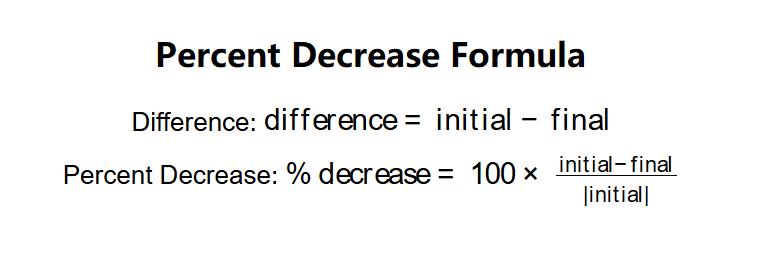1. What is the Percent Decrease Calculator?
Definition: This calculator determines the percentage decrease and numerical difference between an initial value and a smaller final value. The percent decrease is calculated using the formula \( \% \text{ decrease} = 100 \times \frac{\text{initial} - \text{final}}{|\text{initial}|} \), and the difference is \( \text{difference} = \text{initial} - \text{final} \).
Purpose: It helps users quantify the relative decrease (as a percentage) and the absolute decrease (numerical difference) between two values, useful in finance (e.g., price reductions), science (e.g., population decline), and everyday scenarios (e.g., budget cuts).
2. How Does the Calculator Work?
The calculator uses the following equations:
- Difference: \( \text{difference} = \text{initial} - \text{final} \)
- Percent Decrease: \( \% \text{ decrease} = 100 \times \frac{\text{initial} - \text{final}}{|\text{initial}|} \)
Where:
- \( \text{initial} \): The starting value;
- \( \text{final} \): The ending value (must be less than or equal to the initial value);
- \( |\text{initial}| \): The absolute value of the initial value (to handle negative initial values).
Steps:
- Enter the initial value.
- Enter the final value.
- The calculator checks that the initial value is not zero (to avoid division by zero) and that the final value is less than or equal to the initial value (to ensure a decrease).
- Calculate the difference by subtracting the final value from the initial value.
- Calculate the percent decrease by dividing the difference by the absolute value of the initial value and multiplying by 100.
- Display both results, formatted in scientific notation if the absolute value is less than 0.001, otherwise with 4 decimal places.
3. Importance of Percent Decrease Calculation
Calculating percent decrease and difference is crucial for:
- Financial Analysis: Measuring price reductions, expense cuts, or investment losses, and understanding the absolute decrease in value.
- Scientific Studies: Analyzing declines in populations, chemical concentrations, or experimental results.
- Business Decisions: Evaluating sales drops or cost reductions, both relatively and absolutely.
- Educational Use: Teaching concepts of relative and absolute decrease in mathematics.
4. Using the Calculator
Example 1 (Price Decrease): Calculate the percent decrease and difference in price from $750 to $590:
- Initial: \( \text{initial} = 750 \);
- Final: \( \text{final} = 590 \);
- Difference: \( \text{difference} = 750 - 590 = 160 \);
- Percent Decrease: \( 100 \times \frac{750 - 590}{|750|} = 100 \times \frac{160}{750} \approx 21.3333 \);
- Result: \( \text{difference} = 160.0000 \), \( \% \text{ decrease} = 21.3333\% \).
Example 2 (Negative Initial Value): Calculate the percent decrease and difference from -10 to -15:
- Initial: \( \text{initial} = -10 \);
- Final: \( \text{final} = -15 \);
- Difference: \( \text{difference} = -10 - (-15) = 5 \);
- Percent Decrease: \( 100 \times \frac{-10 - (-15)}{|-10|} = 100 \times \frac{5}{10} = 50 \);
- Result: \( \text{difference} = 5.0000 \), \( \% \text{ decrease} = 50.0000\% \).
5. Frequently Asked Questions (FAQ)
Q: Why is the absolute value used in the denominator for percent decrease?
A: The absolute value ensures the calculation is meaningful even if the initial value is negative, as it measures the magnitude of the decrease relative to the initial value's size.
Q: What happens if the final value is greater than the initial value?
A: The calculator will display an error message, as this scenario indicates an increase, not a decrease.
Q: How precise are the results?
A: Both the difference and percent decrease are displayed with 4 decimal places, or in scientific notation if the value is less than 0.001, ensuring high precision.
Percent Decrease Calculator© - All Rights Reserved 2025
 Home
Home
 Back
Back
